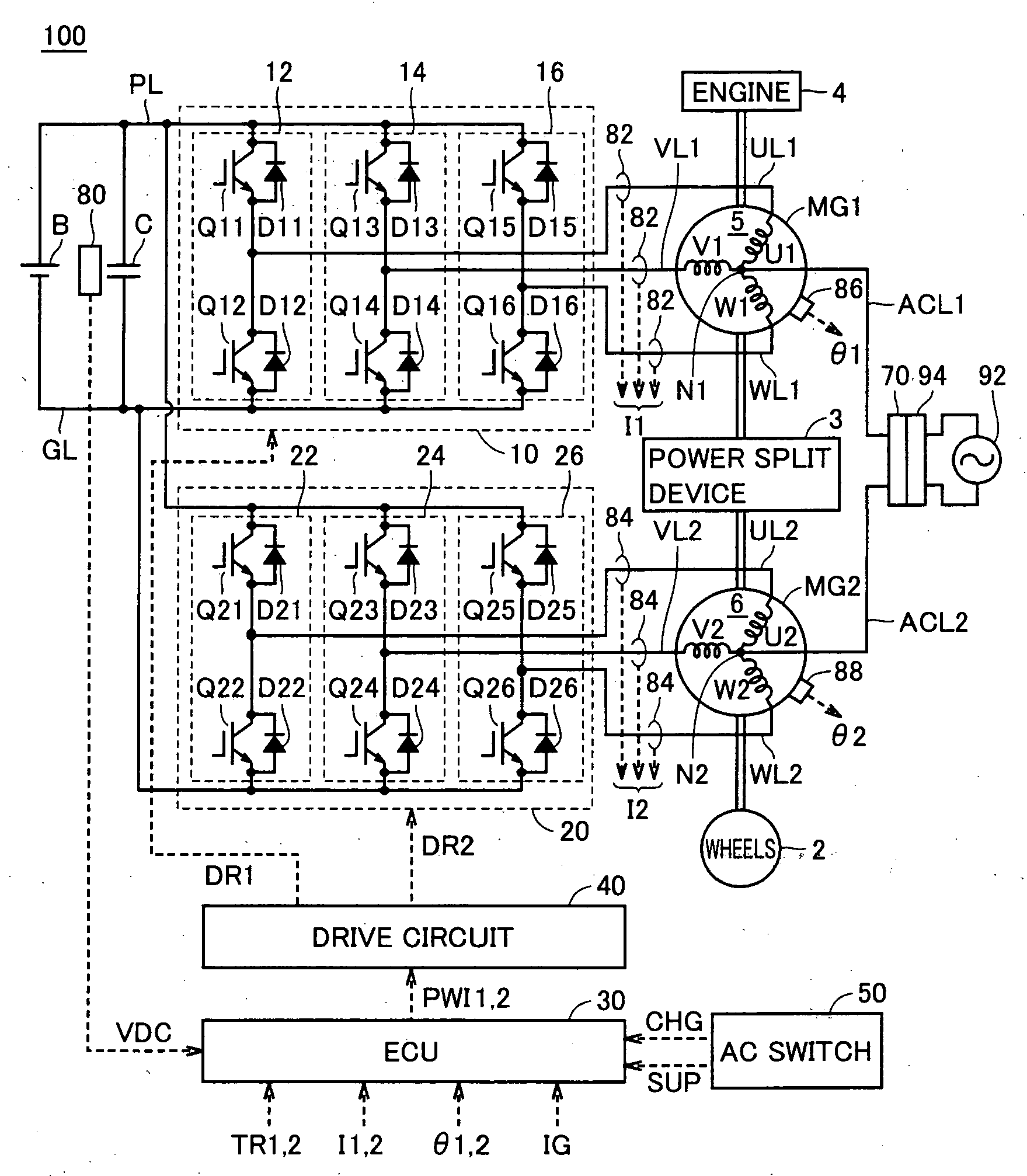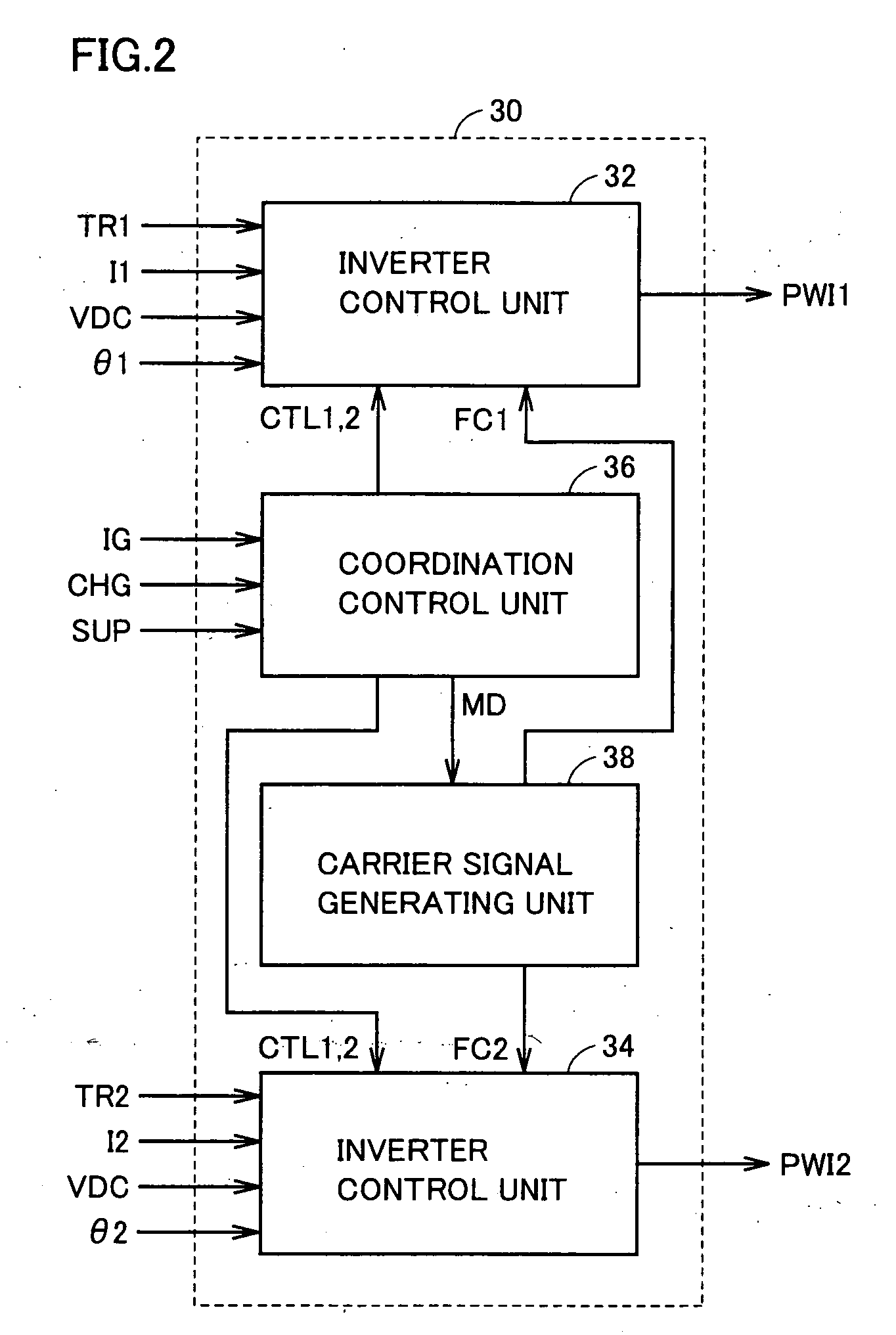Electrically Powered Vehicle
- Summary
- Abstract
- Description
- Claims
- Application Information
AI Technical Summary
Benefits of technology
Problems solved by technology
Method used
Image
Examples
embodiment 1
[0033]FIG. 1 is an overall block diagram of the hybrid vehicle shown as an example of the electrically powered vehicle in accordance with the present invention. Referring to FIG. 1, a hybrid vehicle 100 includes an engine 4, motor generators MG1 and MG2, a power split device 3, and wheels 2. Hybrid vehicle 100 further includes a power storage device B, inverters 10 and 20, an ECU (Electronic Control Unit) 30, a drive circuit 40 and an AC switch 50.
[0034]Hybrid vehicle 100 further includes a power line PL, a ground line GL, a capacitor C, U-phase lines UL1 and UL2, V-phase lines VL1 and VL2, W-phase lines WL1 and WL2, a voltage sensor 80, current sensors 82 and 84, and rotation angle sensors 86 and 88. Further, hybrid vehicle 100 includes power lines ACL1 and ACL2 and a connector 70.
[0035]Hybrid vehicle 100 runs using engine 4 and motor generator MG2 as power sources. Power split device 3 is coupled to engine 4 and to motor generators MG1 and MG2, and distributes power among these. B...
modification 1
of Embodiment 1
[0074]In Modification 1, the carrier frequency fc for the charge / discharge mode is set only in late night hours when the noise is particularly bothering.
[0075]FIG. 5 is a flowchart for setting the carrier frequency in accordance with Modification 1 of Embodiment 1. Referring to FIG. 5, the flowchart includes, in addition to the flowchart of FIG. 4, a step S12. Specifically, if it is determined at step S10 that the operation is in the charge / discharge mode, carrier signal generating unit 38 determines whether it is in a preset late night hours (for example, 22:00 to 6:00) or not (step S12).
[0076]If the time is determined to be in the late night hours (YES at step S12), control proceeds to step S20 at which carrier signal generating unit 38 sets the carrier frequency of each of carrier signals FC1 and FC2 to the frequency fc for the charge / discharge mode.
[0077]If it is determined at step S12 that the time is not in the late night hours (NO at step S12), control proceeds...
modification 2
of Embodiment 1
[0078]In Modification 2, noise around the vehicle is detected and the carrier frequency fc for the charge / discharge mode is set only when noise around the vehicle is low.
[0079]FIG. 6 is an overall block diagram of a hybrid vehicle in accordance with Modification 2 of Embodiment 1. Referring to FIG. 6, hybrid vehicle 100A includes, in addition to the configuration of hybrid vehicle 100 shown in FIG. 1, a noise sensor 52, and includes, in place of ECU 30, an ECU 30A.
[0080]Noise sensor 52 detects noise level around hybrid vehicle 100A, and outputs a signal DB that changes in accordance with the detected noise level, to ECU 30A.
[0081]ECU 30A determines the operation mode (running mode, charge / discharge mode) of inverters 10 and 20 based on the ignition signal IG and the charge request signal CHG and supply request signal SUP from AC switch 50, and based on the determined operation mode and the signal DB from noise sensor 52, determines carrier frequency of the carrier sig...
PUM
 Login to View More
Login to View More Abstract
Description
Claims
Application Information
 Login to View More
Login to View More - R&D
- Intellectual Property
- Life Sciences
- Materials
- Tech Scout
- Unparalleled Data Quality
- Higher Quality Content
- 60% Fewer Hallucinations
Browse by: Latest US Patents, China's latest patents, Technical Efficacy Thesaurus, Application Domain, Technology Topic, Popular Technical Reports.
© 2025 PatSnap. All rights reserved.Legal|Privacy policy|Modern Slavery Act Transparency Statement|Sitemap|About US| Contact US: help@patsnap.com



